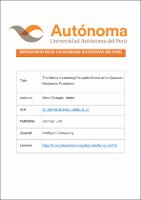| dc.contributor.author | Nieto-Chaupis, Huber | |
| dc.date.accessioned | 2023-10-04T19:38:24Z | |
| dc.date.available | 2023-10-04T19:38:24Z | |
| dc.date.issued | 2022 | |
| dc.identifier.uri | https://hdl.handle.net/20.500.13067/2667 | |
| dc.description.abstract | Quantum mechanics is governed by well-defined postulates by the which one can go through either theory or experimental studies in order to perform measurements of microscopic dynamics of elementary particles, atoms and molecules for instance. By knowing the Tom Mitchell criteria inside Machine Learning, then one can wonder about the postulates of Quantum Mechanics in the entire picture of Mitchell criteria. This paper tries to answer this question. In essence it is focused on the role of brackets formalism and how it makes more feasible to project the ground principles of Quantum Mechanics in the arena of Machine Learning and Artificial Intelligence. | es_PE |
| dc.format | application/pdf | es_PE |
| dc.language.iso | eng | es_PE |
| dc.publisher | Springer Link | es_PE |
| dc.rights | info:eu-repo/semantics/restrictedAccess | es_PE |
| dc.rights.uri | https://creativecommons.org/licenses/by-nc-nd/4.0/ | es_PE |
| dc.subject | Quantum mechanics | es_PE |
| dc.subject | Machine learning | es_PE |
| dc.subject | Tom Mitchell | es_PE |
| dc.title | The Machine Learning Principles Based at the Quantum Mechanics Postulates | es_PE |
| dc.type | info:eu-repo/semantics/article | es_PE |
| dc.identifier.journal | Intelligent Computing | es_PE |
| dc.identifier.doi | https://doi.org/10.1007/978-3-031-10461-9_27 | |
| dc.subject.ocde | https://purl.org/pe-repo/ocde/ford#2.02.04 | es_PE |


